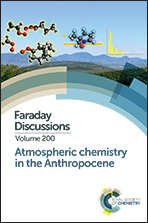Atmospheric gas-to-particle conversion: why NPF events are observed in megacities?
Abstract
In terms of the global aerosol particle number load, atmospheric new particle formation (NPF) dominates over primary emissions. The key for quantifying the importance of atmospheric NPF is to understand how gas-to-particle conversion (GTP) takes place at sizes below a few nanometers in particle diameter in different environments, and how this nano-GTP affects the survival of small clusters into larger sizes. The survival probability of growing clusters is tied closely to the competition between their growth and scavenging by pre-existing aerosol particles, and the key parameter in this respect is the ratio between the condensation sink (CS) and the cluster growth rate (GR). Here we define their ratio as a dimensionless survival parameter, P, as P = (CS/10−4 s−1)/(GR/nm h−1). Theoretical arguments and observations in clean and moderately-polluted conditions indicate that P needs to be smaller than about 50 for a notable NPF to take place. However, the existing literature shows that in China, NPF occurs frequently in megacities such as in Beijing, Nanjing and Shanghai, and our analysis shows that the calculated values of P are even larger than 200 in these cases. By combining direct observations and conceptual modelling, we explore the variability of the survival parameter P in different environments and probe the reasons for NPF occurrence under highly-polluted conditions.
- This article is part of the themed collection: Atmospheric chemistry in the Anthropocene


 Please wait while we load your content...
Please wait while we load your content...